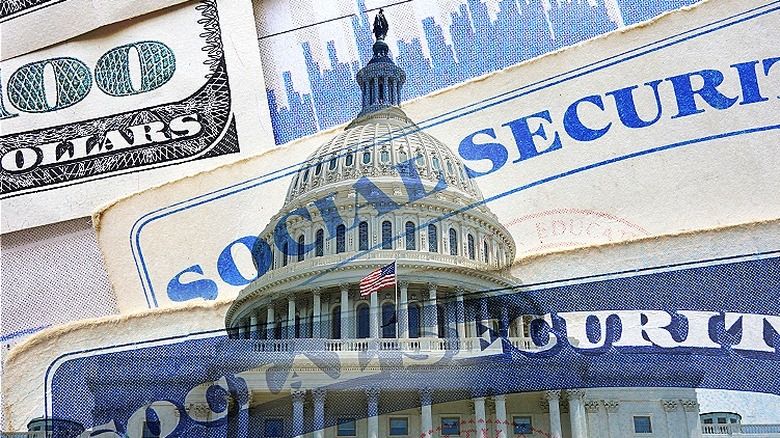Watchdog Group Reports On The Impact Of Trump's Tax Plan On Social Security
The Committee for a Responsible Federal Budget (CRFB), a nonpartisan watchdog organization, released a report on October 21, 2024, that said Donald Trump's plan for a second term would hasten Social Security's insolvency, reducing the current timeline from nine years to six.
As the Republican presidential nominee in the upcoming November 2024 election, Donald Trump has talked about fiscal policies like eliminating taxes on tips and his preference in applying tariffs on imported goods. While serving as the 45th president of the United States (2017-21), Trump presided over the largest tax code legislation to become law in 30 years (the Tax Cuts and Jobs Act of 2017), and his administration also saw a continuation of the inflation reduction that began under President Barack Obama's administration before it. During Trump's first term in office, there was also notably low unemployment rates until the pandemic upended positive economic momentum in the country and across the globe.
Even so, the world is quite different today than it was when Trump took office in 2017, through a multiplicity of factors. For one thing, Social Security is nearly nine years closer to a flashpoint long in the making, with the Social Security Administration's Board of Trustees announcing earlier in 2024 that Social Security reductions will begin in 2035 (versus 2034). That said, according to the CRFB's report, Trump's economic plans for a second term as president appear set to worsen this looming crisis.
The future of Social Security (as of right now)
As said, the Social Security Administration's Board of Trustees announced that Social Security's insolvency wouldn't happen until 2035, or roughly nine years away. Firstly, however, it's crucially important to clear up one key concern: The Social Security program is not going to run out of money. However, if nothing is done to avert this outcome, benefits will be cut by almost 20% to continue providing for beneficiaries to the best of the trust fund's ability. Since 2010, Social Security costs have exceeded the non-interest income of the fund, and total cost outpaced total income in 2021. It hasn't receded in the years since.
Simply put, this all means change will come into the Social Security program's organization. This will either take the form of legislative action that can stave off reduced benefits and the trust fund's insolvency, or the elimination of the buffer between incoming tax dollars and outgoing payments to beneficiaries, thus reducing the amount paid out in the process. It will happen if nothing is done to change the math, and it's a matter of when not if. (See five factors that reduce your Social Security benefit today.)
The Trump plan would hasten Social Security's insolvency
In its report, the Committee for a Responsible Federal Budget found that Donald Trump's plans for taxation and economic mobility, like ending taxes on tips and overtime pay, would weaken the Social Security program further, rather than to help stabilize it. Eliminating taxes on tips might sound like a nice idea, and it's certainly catchy, but it will accomplish exactly no change for the vast majority of tip-earning workers in the U.S. (via reporting from PBS).
The larger issues at play are an elimination of tax on Social Security benefits and the tariff plans Trump has repeatedly discussed in his campaign. Social Security benefits are indeed taxable, but this feature only comes into play for middle and high earners and won't affect most beneficiaries. (For individual filers, the combined income threshold starts at $25,000 and for joint filers, $32,000.) The result is a modest tax increase for some that amounts to a $94 billion collective investment in SSA programs that ultimately go back toward helping the people collecting benefits in the first place.
Moreover, these tax rules have been in place since 1984 and aren't exactly controversial. An earlier CRFB report estimates that eliminating this feature of the tax structure would push up the insolvency date for the trust fund by more than a year, and advance the Medicare Hospital Insurance trust fund insolvency timeline by six. All told, Trump's policy prescriptions for a second term would push up the insolvency date by three years — leaving the federal government far less time to act in preservation of the program. A potential Trump presidency would last until 2029, with just two years separating an exit from office and the looming insolvency date.
The Harris plan doesn't eliminate future hazards either
Social Security policy is difficult to balance since reducing benefits massively hinders financial stability (for example, the benefits lift an estimated 16.5 million senior citizens out of poverty), and raising taxes is never something favorable among the electorate.
As for the Democratic Party's presidential candidate, Vice President Kamala Harris, her campaign has remained tight-lipped on its stance when it comes to Social Security. However, there are some ideas, one being the "donut hole" approach championed by President Joe Biden and (in the past) his vice president. In its current format, the first $168,600 you earn (in 2024) will be assessed a Social Security tax, but beyond that figure, no additional earnings will be affected. This tax approach would see a gap between that number and a much larger earnings figure. Tax filers earning over $400,000 would be required to contribute more to the program, but an earner making, say, $390,000, wouldn't be subjected to additional taxes (with the existing tax structure essentially remaining intact for their personal tax obligation).
Kamala Harris has also suggested raising the ceiling instead, perhaps to $250,000. The donut-hole approach would eliminate an estimated 60% of the Social Security shortfall projection. Either option is great for middle and low earners, but doesn't completely resolve the insolvency cliff. Harris hasn't said it, but bipartisan support also stands behind phasing in another raise to the full retirement age (to 68), according to the University of Maryland's Program for Public Consultation. This would reduce the shortfall by an additional 15%, but negatively affects anyone not yet retired.



